Lenvatinib
Editor-In-Chief: C. Michael Gibson, M.S., M.D. [1]; Associate Editor(s)-in-Chief: Aparna Vuppala, M.B.B.S. [2]
Disclaimer
WikiDoc MAKES NO GUARANTEE OF VALIDITY. WikiDoc is not a professional health care provider, nor is it a suitable replacement for a licensed healthcare provider. WikiDoc is intended to be an educational tool, not a tool for any form of healthcare delivery. The educational content on WikiDoc drug pages is based upon the FDA package insert, National Library of Medicine content and practice guidelines / consensus statements. WikiDoc does not promote the administration of any medication or device that is not consistent with its labeling. Please read our full disclaimer here.
Overview
Lenvatinib is an tyrosine kinase inhibitor that is FDA approved for the treatment of patients with locally recurrent or metastatic, progressive, radioactive iodine-refractory differentiated thyroid cancer (DTC). Common adverse reactions include hypertension, fatigue, diarrhea, arthralgia/myalgia, decreased appetite, weight decreased, nausea, stomatitis, headache, vomiting, proteinuria, palmar-plantar erythrodysesthesia (PPE) syndrome, abdominal pain, and dysphonia. pneumonia, hypertension , and dehydration ..
Adult Indications and Dosage
FDA-Labeled Indications and Dosage (Adult)
Thyroid cancer (DTC)
- Lenvatinib is indicated for the treatment of patients with locally recurrent or metastatic, progressive, radioactive iodine-refractory differentiated thyroid cancer (DTC).
Dosing Information
Recommended Dose
- The recommended daily dose of Lenvatinib is 24 mg (two 10 mg capsules and one 4 mg capsule) orally taken once daily with or without food . Continue Lenvatinib until disease progression or until unacceptable toxicity occurs.
- Take Lenvatinib at the same time each day. If a dose is missed and cannot be taken within 12 hours, skip that dose and take the next dose at the usual time of administration.
- Severe Renal or Hepatic Impairment
- The recommended dose of Lenvatinib is 14 mg taken orally once daily in patients with severe renal impairment (creatinine clearance [CLcr] less than 30 mL/min calculated by the Cockroft-Gault equation) or severe hepatic impairment (Child-Pugh C).
Dose Modifications
- Hypertension
- Assess blood pressure prior to and periodically during treatment. Initiate or adjust medical management to control blood pressure prior to and during treatment
- Withhold Lenvatinib for Grade 3 hypertension that persists despite optimal antihypertensive therapy; resume at a reduced dose (see Table 1) when hypertension is controlled at less than or equal to Grade 2.
- Discontinue Lenvatinib for life-threatening hypertension.
- Discontinue for a Grade 4 event.
- Withhold Lenvatinib for development of Grade 3 event until improved to Grade 0 or 1 or baseline.
- Either resume at a reduced dose (see Table 1) or discontinue Lenvatinib depending on the severity and persistence of the adverse event.
- Arterial thrombotic event
- Discontinue Lenvatinib following an arterial thrombotic event.
- Renal failure and impairment or hepatotoxicity
- Withhold Lenvatinib for development of Grade 3 or 4 renal failure/impairment or hepatotoxicity until resolved to Grade 0 to 1 or baseline.
- Either resume at a reduced dose (see Table 1) or discontinue Lenvatinib depending on the severity and persistence of renal impairment or hepatotoxicity.
- Discontinue Lenvatinib for hepatic failure.
- Withhold Lenvatinib for ≥2 grams of proteinuria/24 hours.
- Resume at a reduced dose (see Table 1) when proteinuria is <2 gm/24 hours.
- Discontinue Lenvatinib for nephrotic syndrome. Gastrointestinal perforation or fistula formation
- Discontinue Lenvatinib in patients who develop gastrointestinal perforation or lifethreatening fistula.
- Withhold Lenvatinib for the development of Grade 3 or greater QT interval prolongation.
- Resume Lenvatinib at a reduced dose (see Table 1) when QT prolongation resolves to Grade 0 or 1 or baseline.
- Withhold for RPLS until fully resolved.
- Upon resolution, resume at a reduced dose or discontinue Lenvatinib depending on the severity and persistence of neurologic symptoms.
- Manage other adverse reactions according to the instructions in Table 1. Based on the absence of clinical experience, there are no recommendations on resumption of dosing in patients with Grade 4 clinical adverse reactions that resolve.
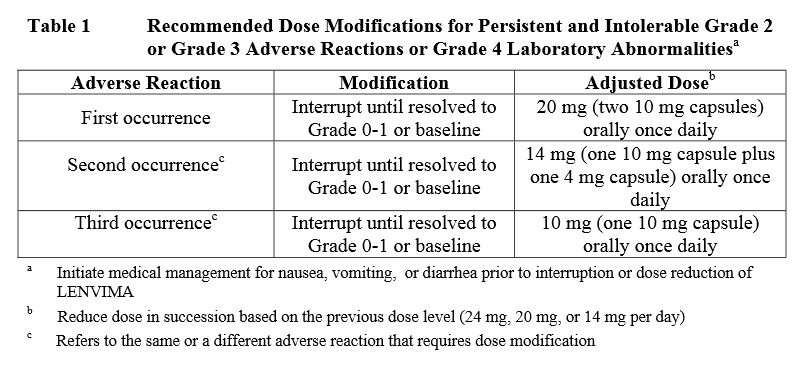
Off-Label Use and Dosage (Adult)
Guideline-Supported Use
There is limited information regarding Off-Label Guideline-Supported Use of Lenvatinib in adult patients.
Non–Guideline-Supported Use
There is limited information regarding Off-Label Non–Guideline-Supported Use of Lenvatinib in adult patients.
Pediatric Indications and Dosage
FDA-Labeled Indications and Dosage (Pediatric)
There is limited information regarding FDA-Labeled Use of Lenvatinib in pediatric patients.
Off-Label Use and Dosage (Pediatric)
Guideline-Supported Use
There is limited information regarding Off-Label Guideline-Supported Use of Lenvatinib in pediatric patients.
Non–Guideline-Supported Use
There is limited information regarding Off-Label Non–Guideline-Supported Use of Lenvatinib in pediatric patients.
Contraindications
- None.
Warnings
Hypertension
- In Study 1 hypertension was reported in 73% of Lenvatinib-treated patients and 16% of patients in the placebo group . The median time to onset of new or worsening hypertension was 16 days for Lenvatinib-treated patients. The incidence of Grade 3 hypertension was 44% as compared to 4% for placebo, and the incidence of Grade 4 hypertension was less than 1% in Lenvatinib-treated patients and none in the placebo group.
- Control blood pressure prior to treatment with Lenvatinib. Monitor blood pressure after 1 week, then every 2 weeks for the first 2 months, and then at least monthly thereafter during treatment with Lenvatinib. Withhold Lenvatinib for Grade 3 hypertension despite optimal antihypertensive therapy; resume at a reduced dose when hypertension is controlled at less than or equal to Grade 2. Discontinue Lenvatinib for life-threatening hypertension .
Cardiac Dysfunction
- In Study 1, cardiac dysfunction, defined as decreased left or right ventricular function, cardiac failure, or pulmonary edema, was reported in 7% of Lenvatinib-treated patients (2% Grade 3 or greater) and 2% (no Grade 3 or greater) of patients in the placebo group. The majority of these cases in Lenvatinib-treated patients (14 of 17 cases) were based on findings of decreased ejection fraction as assessed by echocardiography. Six of 261 (2%) Lenvatinib-treated patients in Study 1 had greater than 20% reduction in ejection fraction as measured by echocardiography compared to no patients who received placebo.
- Monitor patients for clinical symptoms or signs of cardiac decompensation. Withhold Lenvatinib for development of Grade 3 cardiac dysfunction until improved to Grade 0 or 1 or baseline. Either resume at a reduced dose or discontinue Lenvatinib depending on the severity and persistence of cardiac dysfunction. Discontinue Lenvatinib for Grade 4 cardiac dysfunction .
Arterial Thromboembolic Events
- In Study 1, arterial thromboembolic events were reported in 5% of Lenvatinib-treated patients and 2% of patients in the placebo group. The incidence of arterial thromboembolic events of Grade 3 or greater was 3% in Lenvatinib-treated patients and 1% in the placebo group.
- Discontinue Lenvatinib following an arterial thromboembolic events. The safety of resuming Lenvatinib after an arterial thromboembolic events has not been established and Lenvatinib has not been studied in patients who have had an arterial thromboembolic events within the previous 6 months
Hepatotoxicity
- In Study 1, 4% of Lenvatinib-treated patients experienced an increase in alanine aminotransferase (ALT) and 5% experienced an increase in aspartate aminotransferase (AST) that was Grade 3 or greater. No patients in the placebo group experienced Grade 3 or greater increases in ALT or AST. Across clinical studies in which 1108 patients received Lenvatinib, hepatic failure (including fatal events) was reported in 3 patients and acute hepatitis was reported in 1 patient.
- Monitor liver function before initiation of Lenvatinib, then every 2 weeks for the first 2 months, and at least monthly thereafter during treatment. Withhold Lenvatinib for the development of Grade 3 or greater liver impairment until resolved to Grade 0 to 1 or baseline. Either resume at a reduced dose or discontinue Lenvatinib depending on the severity and persistence of hepatotoxicity. Discontinue Lenvatinib for hepatic failure .
proteinuria
- In Study 1, proteinuria was reported in 34% of Lenvatinib-treated patients and 3% of patients in the placebo group. The incidence of Grade 3 proteinuria in Lenvatinib-treated patients was 11% compared to none in the placebo group.
- Monitor for proteinuria before initiation of, and periodically throughout treatment. If urine dipstick proteinuria greater than or equal to 2+ is detected, obtain a 24 hour urine protein. Withhold Lenvatinib for ≥2 grams of proteinuria/24 hours and resume at a reduced dose when proteinuria is <2 gm/24 hours. Discontinue Lenvatinib for nephrotic syndrome .
Renal Failure and Impairment
- In Study 1, events of renal impairment were reported in 14% of Lenvatinib-treated patients compared to 2% of patients in the placebo group. The incidence of Grade 3 or greater renal failure or impairment was 3% in Lenvatinib-treated patients and 1% in the placebo group. The primary risk factor for severe renal impairment in Lenvatinib-treated patients was dehydration/hypovolemia due to diarrhea and vomiting.
- Withhold Lenvatinib for development of Grade 3 or 4 renal failure/impairment until resolved to Grade 0 to 1 or baseline. Either resume at a reduced dose or discontinue Lenvatinib depending on the severity and persistence of renal impairment
Gastrointestinal Perforation and fistula
- Formation In Study 1, events of gastrointestinal perforation or fistula were reported in 2% of Lenvatinib-treated patients and 0.8% of patients in the placebo group.
- Discontinue Lenvatinib in patients who develop gastrointestinal perforation or lifethreatening fistula
QT Interval Prolongation
- In Study 1, QT/QTc interval prolongation was reported in 9% of Lenvatinib-treated patients and 2% of patients in the placebo group. The incidence of QT interval prolongation of Grade 3 or greater was 2% in Lenvatinib-treated patients compared to no reports in the placebo group. Monitor electrocardiograms in patients with congenital long QT syndrome, congestive heart failure, bradyarrhythmias, or those who are taking drugs known to prolong the QT interval, including Class Ia and III antiarrhythmics.
- Monitor and correct electrolyte abnormalities in all patients. Withhold Lenvatinib for the development of Grade 3 or greater QT interval prolongation. Resume Lenvatinib at a reduced dose when QT prolongation resolves to Grade 0 or 1 or baseline
Hypocalcemia
- In Study 1, 9% of Lenvatinib-treated patients experienced Grade 3 or greater hypocalcemia compared to 2% in the placebo group. In most cases hypocalcemia responded to replacement and dose interruption/dose reduction .
- Monitor blood calcium levels at least monthly and replace calcium as necessary during Lenvatinib treatment. Interrupt and adjust Lenvatinib dosing as necessary depending on severity, presence of ECG changes, and persistence of hypocalcemia
Reversible Posterior Leukoencephalopathy Syndrome
- Across clinical studies in which 1108 patients received Lenvatinib, there were 3 reported events of reversible posterior leukoencephalopathy syndrome (RPLS). Confirm the diagnosis of RPLS with MRI. Withhold for RPLS until fully resolved. Upon resolution, resume at a reduced dose or discontinue Lenvatinib depending on the severity and persistence of neurologic symptoms
Hemorrhagic Events
- In Study 1, hemorrhagic events occurred in 35% of Lenvatinib-treated patients and in 18% of the placebo group. However, the incidence of Grade 3-5 hemorrhage was similar between arms at 2% and 3%, respectively. The most frequently reported hemorrhagic event was epistaxis (11% Grade 1 and 1% Grade 2). Discontinuation due to hemorrhagic events occurred in 1% of Lenvatinib-treated patients.
- Across clinical studies in which 1108 patients received Lenvatinib, Grade 3 or greater hemorrhage was reported in 2% of patients. In Study 1, there was 1 case of fatal intracranial hemorrhage among 16 patients who received lenvatinib and had CNS metastases at baseline.
- Withhold Lenvatinib for the development of Grade 3 hemorrhage until resolved to Grade 0 to 1. Either resume at a reduced dose or discontinue Lenvatinib depending on the severity and persistence of hemorrhage. Discontinue Lenvatinib in patients who experience Grade 4 hemorrhage .
Impairment of Thyroid Stimulating Hormone Suppression
- Lenvatinib impairs exogenous thyroid suppression. In Study 1, 88% of all patients had a baseline thyroid stimulating hormone (TSH) level less than or equal to 0.5 mU/L. In those patients with a normal TSH at baseline, elevation of TSH level above 0.5 mU/L was observed post baseline in 57% of Lenvatinib-treated patients as compared with 14% of patients receiving placebo.
- Monitor TSH levels monthly and adjust thyroid replacement medication as needed in patients with DTC.
Embryofetal Toxicity
- Based on its mechanism of action and data from animal reproduction studies, Lenvatinib can cause fetal harm when administered to a pregnant woman. In animal reproduction studies, oral administration of lenvatinib during organogenesis at doses below the recommended human dose resulted in embryotoxicity, fetotoxicity, and teratogenicity in rats and rabbits. Advise pregnant women of the potential risk to a fetus. Advise females of reproductive potential to use effective contraception during treatment with Lenvatinib and for at least 2 weeks following completion of therapy
Adverse Reactions
Clinical Trials Experience
- The following adverse reactions are discussed elsewhere in the label
- Hypertension
- Cardiac Dysfunction
- Arterial Thromboembolic Events
- Hepatotoxicity
- proteinuria
- Renal Failure and Impairment
- Gastrointestinal Perforation and fistula Formation
- QT interval prolongation
- Hypocalcemia
- Reversible Posterior Leukoencephalopathy Syndrome
- Hemorrhagic Events
- Impairment of Thyroid Stimulating Hormone Suppression
Clinical Trials Experience
- Because clinical trials are conducted under widely varying conditions, adverse reaction rates observed in the clinical trials of a drug cannot be directly compared to rates in the clinical trials of another drug and may not reflect the rates observed in practice.
- Safety data obtained in 1108 patients with advanced solid tumors who received Lenvatinib as a single agent across multiple clinical studies was used to further characterize risks of serious adverse drug reactions . The median age was 60 years (range 21-89 years). The dose range was 0.2 mg to 32 mg. The median duration of exposure in the entire population was 5.5 months.
- The safety data described below are derived from Study 1 which randomized (2:1) patients with radioactive iodine-refractory differentiated thyroid cancer (RAI-refractory DTC) to Lenvatinib (n=261) or placebo (n=131) . The median treatment duration was 16.1 months for Lenvatinib and 3.9 months for placebo. Among 261 patients who received Lenvatinib in Study 1, median age was 64 years, 52% were women, 80% were White, 18% were Asian, and 2% were Black; 4% identified themselves as having Hispanic or Latino ethnicity.
- In Study 1, the most common adverse reactions observed in Lenvatinib-treated patients (greater than or equal to 30%) were, in order of decreasing frequency, hypertension, fatigue, diarrhea, arthralgia/myalgia, decreased appetite, weight decreased, nausea, stomatitis, headache, vomiting, proteinuria, palmar-plantar erythrodysesthesia (PPE) syndrome, abdominal pain, and dysphonia. The most common serious adverse reactions (at least 2%) were pneumonia (4%), hypertension (3%), and dehydration (3%).
- Adverse reactions led to dose reductions in 68% of patients receiving Lenvatinib and 5% of patients receiving placebo; 18% of patients discontinued Lenvatinib and 5% discontinued placebo for adverse reactions. The most common adverse reactions (at least 10%) resulting in dose reductions of Lenvatinib were hypertension (13%), proteinuria (11%), decreased appetite (10%), and diarrhea (10%); the most common adverse reactions (at least 1%) resulting in discontinuation of Lenvatinib were hypertension (1%) and asthenia (1%).
- Table 2 presents the percentage of patients in Study 1 experiencing adverse reactions at a higher rate in Lenvatinib-treated patients than patients receiving placebo in the double-blind phase of the DTC study.
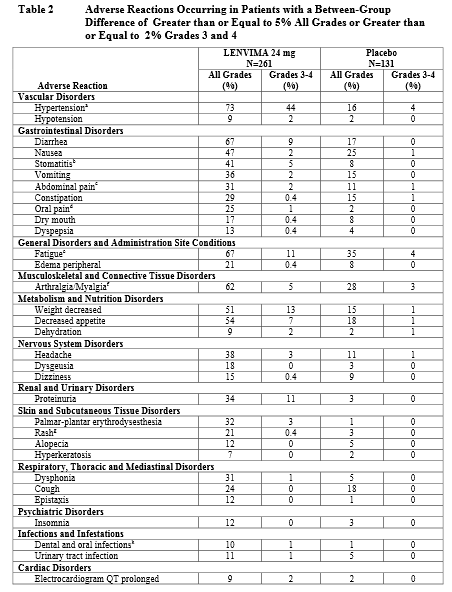
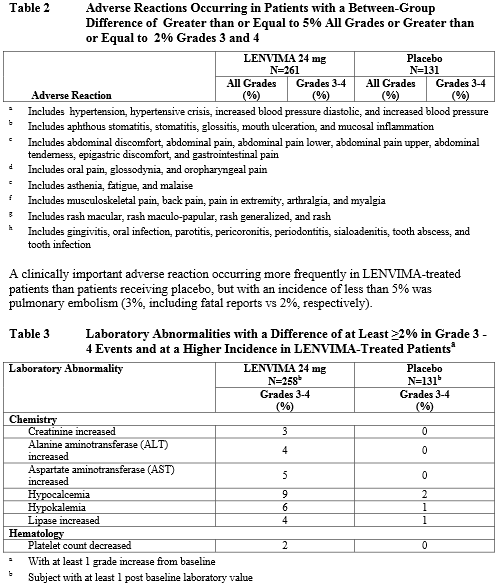
- In addition the following laboratory abnormalities (all Grades) occurred in greater than 5% of Lenvatinib-treated patients and at a rate that was two-fold or higher than in patients who received placebo: hypoalbuminemia, increased alkaline phosphatase, hypomagnesemia, hypoglycemia, hyperbilirubinemia, hypercalcemia, hypercholesterolemia, increased serum amylase, and hyperkalemia.
Postmarketing Experience
There is limited information regarding Postmarketing Experience of Lenvatinib in the drug label.
Drug Interactions
- Effect of Other Drugs on Lenvatinib No dose adjustment of Lenvatinib is recommended when co-administered with CYP3A, Pglycoprotein (P-gp), and breast cancer resistance protein (BCRP) inhibitors and CYP3A and P-gp inducer
Use in Specific Populations
Pregnancy
- Risk Summary Based on its mechanism of action and data from animal reproduction studies, Lenvatinib can cause fetal harm when administered to a pregnant woman . In animal reproduction studies, oral administration of lenvatinib during organogenesis at doses below the recommended human dose resulted in embryotoxicity, fetotoxicity, and teratogenicity in rats and rabbits . There are no available human data informing the drug-associated risk. Advise pregnant women of the potential risk to a fetus.
- The background risk of major birth defects and miscarriage for the indicated population is unknown; however, the background risk in the U.S. general population of major birth defects is 2-4% and of miscarriage is 15-20% of clinically recognized pregnancies.
Data
Animal Data
- In an embryofetal development study, daily oral administration of lenvatinib mesylate at doses greater than or equal to 0.3 mg/kg [approximately 0.14 times the recommended human dose based on body surface area (BSA)] to pregnant rats during organogenesis resulted in dose-related decreases in mean fetal body weight, delayed fetal ossifications, and doserelated increases in fetal external (parietal edema and tail abnormalities), visceral, and skeletal anomalies. Greater than 80% postimplantation loss was observed at 1.0 mg/kg/day (approximately 0.5 times the recommended human dose based on BSA).
- Daily oral administration of lenvatinib mesylate to pregnant rabbits during organogenesis resulted in fetal external (short tail), visceral (retroesophageal subclavian artery), and skeletal anomalies at doses greater than or equal to 0.03 mg/kg (approximately 0.03 times the human dose of 24 mg based on body surface area). At the 0.03 mg/kg dose, increased postimplantation loss, including 1 fetal death, was also observed. Lenvatinib was abortifacient in rabbits, resulting in late abortions in approximately one-third of the rabbits treated at a dose level of 0.5 mg/kg/day (approximately 0.5 times the recommended clinical dose of 24 mg based on BSA).
Pregnancy Category (AUS):
There is no Australian Drug Evaluation Committee (ADEC) guidance on usage of Lenvatinib in women who are pregnant.
Labor and Delivery
There is no FDA guidance on use of Lenvatinib during labor and delivery.
Nursing Mothers
Risk Summary
- It is not known whether Lenvatinib is present in human milk. However, lenvatinib and its metabolites are excreted in rat milk at concentrations higher than in maternal plasma
Because of the potential for serious adverse reactions in nursing infants from Lenvatinib, advise women to discontinue breastfeeding during treatment with Lenvatinib.
Data
Animal Data
- Following administration of radiolabeled lenvatinib to lactating Sprague Dawley rats, lenvatinib-related radioactivity was approximately 2 times higher (based on AUC) in milk compared to maternal plasma.
Pediatric Use
- The safety and effectiveness of Lenvatinib in pediatric patients have not been established.
Juvenile Animal Data=
- Daily oral administration of lenvatinib mesylate to juvenile rats for 8 weeks starting on postnatal day 21 (approximately equal to a human pediatric age of 2 years) resulted in growth retardation (decreased body weight gain, decreased food consumption, and decreases in the width and/or length of the femur and tibia) and secondary delays in physical development and reproductive organ immaturity at doses greater than or equal to 2 mg/kg (approximately 1.2 to 5 times the clinical exposure by AUC at the recommended human dose). Decreased length of the femur and tibia persisted following 4 weeks of recovery. In general, the toxicologic profile of lenvatinib was similar between juvenile and adult rats, though toxicities including broken teeth at all dose levels and mortality at the 10 mg/kg/day dose level (attributed to primary duodenal lesions) occurred at earlier treatment time-points in juvenile rats.
Geriatic Use
- Of 261 patients who received Lenvatinib in Study 1, 118 (45.2%) were greater than or equal to 65 years of age and 29 (11.1%) were greater than or equal to 75 years of age. No overall differences in safety or effectiveness were observed between these subjects and younger subjects.
Gender
There is no FDA guidance on the use of Lenvatinib with respect to specific gender populations.
Race
There is no FDA guidance on the use of Lenvatinib with respect to specific racial populations.
Renal Impairment
- No dose adjustment is recommended in patients with mild or moderate renal impairment. In patients with severe renal impairment, the recommended dose is 14 mg taken once daily. Patients with end stage renal disease were not studied
Hepatic Impairment
- No dose adjustment is recommended in patients with mild or moderate hepatic impairment. In patients with severe hepatic impairment, the recommended dose is 14 mg taken once daily
Females of Reproductive Potential and Males
Contraception
- Based on its mechanism of action, Lenvatinib can cause fetal harm when administered to a pregnant woman . Advise females of reproductive potential to use effective contraception during treatment with Lenvatinib and for at least 2 weeks following completion of therapy.
Infertility
=Females=
- Lenvatinib may result in reduced fertility in females of reproductive potential .
Males=
- Lenvatinib may result in damage to male reproductive tissues leading to reduced fertility of unknown duration
Immunocompromised Patients
There is no FDA guidance one the use of Lenvatinib in patients who are immunocompromised.
Administration and Monitoring
Administration
- Oral
Monitoring
There is limited information regarding Monitoring of Lenvatinib in the drug label.
IV Compatibility
There is limited information regarding IV Compatibility of Lenvatinib in the drug label.
Overdosage
- There is no specific antidote for overdose with Lenvatinib. Due to the high plasma protein binding, lenvatinib is not expected to be dialyzable .Adverse reactions in patients receiving single doses of Lenvatinib as high as 40 mg were similar to the adverse events reported in the clinical studies at the recommended dose.
Pharmacology
There is limited information regarding Lenvatinib Pharmacology in the drug label.
Mechanism of Action
- Lenvatinib is a receptor tyrosine kinase (RTK) inhibitor that inhibits the kinase activities of vascular endothelial growth factor (VEGF) receptors VEGFR1 (FLT1), VEGFR2 (KDR), and VEGFR3 (FLT4). Lenvatinib also inhibits other RTKs that have been implicated in pathogenic angiogenesis, tumor growth, and cancer progression in addition to their normal cellular functions, including fibroblast growth factor (FGF) receptors FGFR1, 2, 3, and 4; the platelet derived growth factor receptor alpha (PDGFRα), KIT, and RET.
Structure
- Lenvatinib, a kinase inhibitor, is the mesylate salt of lenvatinib. Its chemical name is 4-[3 chloro-4-(N’-cyclopropylureido)phenoxy]-7-methoxyquinoline-6-carboxamide methanesulfonate. The molecular formula is C21H19ClN4O4 • CH4O3S, and the molecular weight of the mesylate salt is 522.96. The chemical structure of lenvatinib mesylate is:
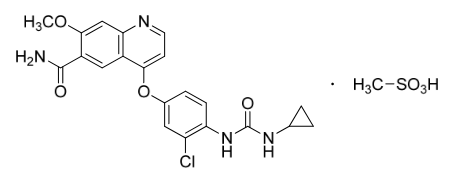
- Lenvatinib mesylate is a white to pale reddish yellow powder. It is slightly soluble in water and practically insoluble in ethanol (dehydrated). The dissociation constant (pKa value) of lenvatinib mesylate is 5.05 at 25°C. The partition coefficient (log P value) is 3.30. Each Lenvatinib capsule contains lenvatinib mesylate equivalent to 4 mg or 10 mg of lenvatinib, and the following inactive ingredients: calcium carbonate, mannitol, microcrystalline cellulose, hydroxypropylcellulose, hydroxypropyl cellulose (type H), and talc. The hypromellose capsule shell contains titanium dioxide, ferric oxide yellow, and ferric oxide red. The printing ink contains shellac, black iron oxide, potassium hydroxide, and propylene glycol
Pharmacodynamics
Cardiac Electrophysiology
- A single 32 mg dose (1.3 times the recommended daily dose) of lenvatinib did not prolong the QT/QTc interval in a thorough QT study in healthy subjects. However, QT prolongation was observed in Study 1
Pharmacokinetics
Absorption
- After oral administration of Lenvatinib, time to peak plasma concentration (Tmax) typically occurred from 1 to 4 hours post-dose. Administration with food did not affect the extent of absorption, but decreased the rate of absorption and delayed the median Tmax from 2 hours to 4 hours.
- In patients with solid tumors administered single and multiple doses of Lenvatinib once daily, the maximum lenvatinib plasma concentration (Cmax) and the area under the concentration- time curve (AUC) increased proportionally over the dose range of 3.2 to 32 mg with a median accumulation index of 0.96 (20 mg) to 1.54 (6.4 mg).
Distribution
- In vitro binding of lenvatinib to human plasma proteins ranged from 98% to 99% (0.3 – 30 μg/mL). In vitro, the lenvatinib blood-to-plasma concentration ratio ranged from 0.589 to 0.608 (0.1 – 10 μg/mL).
- Based on in vitro data, lenvatinib is a substrate of P-gp and BCRP but not a substrate for organic anion transporter (OAT) 1, OAT3, organic anion transporting polypeptide (OATP) 1B1, OATP1B3, organic cation transporter (OCT) 1, OCT2, or the bile salt export pump (BSEP).
Elimination
- Plasma concentrations declined bi-exponentially following Cmax. The terminal elimination half-life of lenvatinib was approximately 28 hours.
Metabolism
- CYP3A is one of the main metabolic enzymes of lenvatinib. The main metabolic pathways for lenvatinib in humans were identified as enzymatic (CYP3A and aldehyde oxidase) and non-enzymatic processes.
Excretion
- Ten days after a single administration of radiolabeled lenvatinib to 6 patients with solid tumors, approximately 64% and 25% of the radiolabel were eliminated in the feces and urine, respectively.
Specific Populations
Renal Impairment
- The pharmacokinetics of lenvatinib following a single 24 mg dose were evaluated in subjects with mild (CLcr 60-89 mL/min), moderate (CLcr 30-59 mL/min), and severe (CLcr <30 mL/min) renal impairment, and compared to healthy subjects. Subjects with end stage renal disease were not studied. After a single 24 mg oral dose of Lenvatinib, the AUC0-inf for subjects with renal impairment were similar compared to those for healthy subjects .
Hepatic Impairment
- The pharmacokinetics of lenvatinib following a single 10 mg dose of Lenvatinib were evaluated in subjects with mild (Child Pugh A) and moderate (Child Pugh B) hepatic impairment. The pharmacokinetics of a single 5 mg dose were evaluated in subjects with severe (Child Pugh C) hepatic impairment. Compared to subjects with normal hepatic function, the dose-adjusted AUC0-inf of lenvatinib for subjects with mild, moderate, and severe hepatic impairment were 119%, 107%, and 180%, respectively .
Effects of Age, Sex, and Race
- Based on a population PK analysis, age, sex, and race did not have a significant effect on apparent clearance (Cl/F) of lenvatinib.
Drug Interaction Studies
Effect of Other Drugs on Lenvatinib
- CYP3A, P-gp, and BCRP Inhibitors: Ketoconazole (400 mg for 18 days) increased lenvatinib (administered as a single dose on Day 5) AUC by 15% and Cmax by 19% in a dedicated clinical trial.
- P-gp Inhibitors: Rifampicin (400 mg as a single dose) increased lenvatinib (24 mg as a single dose)AUC by 31% and Cmax by 33% in a dedicated clinical trial.
- CYP3A and P-gp Inducers: Rifampicin (400 mg administered daily for 21 days) decreased lenvatinib (a single 24 mg administered on Day 15) AUC by 18% in a dedicated clinical trial. The Cmax was unchanged.
Effect of Lenvatinib on Other Drugs
- CYP3A4 or CYP2C8 Substrates: There is no projected significant drug-drug interaction risk between lenvatinib and midazolam (a CYP3A4 substrate) or repaglinide (a CYP2C8 substrate).
- In Vitro Studies with CYP or UDP-glucuronosyltransferase (UGT) Substrates: Lenvatinib inhibits CYP2C8, CYP1A2, CYP2B6, CYP2C9, CYP2C19, CYP2D6, and CYP3A, but an increase in lenvatinib exposure that impacts safety is unlikely. Lenvatinib does not inhibit CYP2A6 and CYP2E1.
- Lenvatinib induces CYP3A, but a decrease in lenvatinib exposure that impacts efficacy is unlikely. Lenvatinib does not induce CYP1A1, CYP1A2, CYP2B6, and CYP2C9. *Lenvatinib directly inhibits UGT1A1 and UGT1A4. The clinical implication of this finding is unknown. Lenvatinibshows little or no inhibition on UGT1A6, UGT1A9, UGT2B7, or aldehyde oxidase.
- Lenvatinib does not induce UGT1A1, UGT1A4, UGT1A6, UGT1A9, or UGT2B7.
- In Vitro Studies with Drug Transporter System Substrates: Lenvatinib inhibits OAT1, OAT3, OCT1, OCT2, OATP1B1, and BSEP. The clinical implication of this finding is unknown. Lenvatinib shows little or no inhibition on OATP1B3.
Nonclinical Toxicology
Carcinogenesis, Mutagenesis, Impairment of Fertility
- Carcinogenicity studies have not been conducted with lenvatinib. Lenvatinib mesylate was not mutagenic in the in vitro bacterial reverse mutation (Ames) assay. Lenvatinib was not clastogenic in the in vitro mouse lymphoma thymidine kinase assay or the in vivo rat micronucleus assay.
- No specific studies with lenvatinib have been conducted in animals to evaluate the effect on fertility; however, results from general toxicology studies in rats, monkeys, and dogs suggest there is a potential for lenvatinib to impair fertility. Male dogs exhibited testicular hypocellularity of the seminiferous epithelium and desquamated seminiferous epithelial cells in the epididymides at lenvatinib exposures approximately 0.02 to 0.09 times the clinical exposure by AUC at the recommended human dose. Follicular atresia of the ovaries was observed in monkeys and rats at exposures 0.2 to 0.8 times and 10 to 44 times the clinical exposure by AUC at the 24 mg clinical dose, respectively. In addition, in monkeys, a decreased incidence of menstruation was reported at lenvatinib exposures lower than those in humans at the 24 mg clinical dose.
Clinical Studies
- A multicenter, randomized (2:1), double-blind, placebo-controlled trial was conducted in 392 patients with locally recurrent or metastatic radioactive iodine-refractory differentiated thyroid cancer and radiographic evidence of disease progression within 12 months prior to randomization, confirmed by independent radiologic review. Radioactive iodine-refractory was defined as 1 or more measurable lesions with no iodine uptake on RAI scan, iodine uptake with progression within 12 months of RAI therapy, or having received cumulative RAI activity of >400 mCi (22 GBq) with the last dose administered at least 6 months prior to study entry. Patients were randomized to receive Lenvatinib 24 mg once daily (n=261) or placebo (n=131) until disease progression. Randomization was stratified by geographic region, prior VEGF/VEGFR-targeted therapy, and age. The major efficacy outcome measure was progression-free survival as determined by blinded independent radiologic review using Response Evaluation Criteria in Solid Tumors (RECIST) 1.1. Independent review confirmation of disease progression was required prior to discontinuing patients from the randomization phase of the study. Other efficacy outcome measures included objective response rate and overall survival. Patients in the placebo arm could receive lenvatinib following independent review confirmation of disease progression.
- Of the 392 patients randomized, 51% were male, the median age was 63 years, 40% were older than 65 years, 79% were White, 54% had an ECOG performance status of 0, and 24% had received 1 prior VEGF/VEGFR-targeted therapy. Metastases were present in 99% of the patients: lungs in 89%, lymph nodes in 52%, bone in 39%, liver in 18%, and brain in 4%. The histological diagnoses were papillary thyroid cancer (66%) and follicular thyroid cancer (34%); of those with follicular histology, 44% had Hürthle cell and 11% had clear cell subtypes. In the Lenvatinib arm, 67% of patients did not demonstrate iodine uptake on any radioiodine scan compared to 77% in the placebo arm. Additionally, 59% of patients on the Lenvatinib arm and 61% of patients on placebo arm progressed, according to RECIST 1.1, within 12 months of prior 131I therapy; 19.2% of patients on the Lenvatinib arm and 17.6% of patients on placebo arm received prior cumulative activity of >400 mCi or 22 gigabecquerels (GBq) 131I, with the last dose administered at least 6 months prior to study entry. The median cumulative RAI activity administered prior to study entry was 350 mCi (12.95 GBq).
- A statistically significant prolongation in PFS was demonstrated in Lenvatinib-treated patients compared to those receiving placebo (see Table 4 and Figure 1). Upon confirmation of progression, 109 (83%) patients randomly assigned to placebo crossed over to receive open-label Lenvatinib.
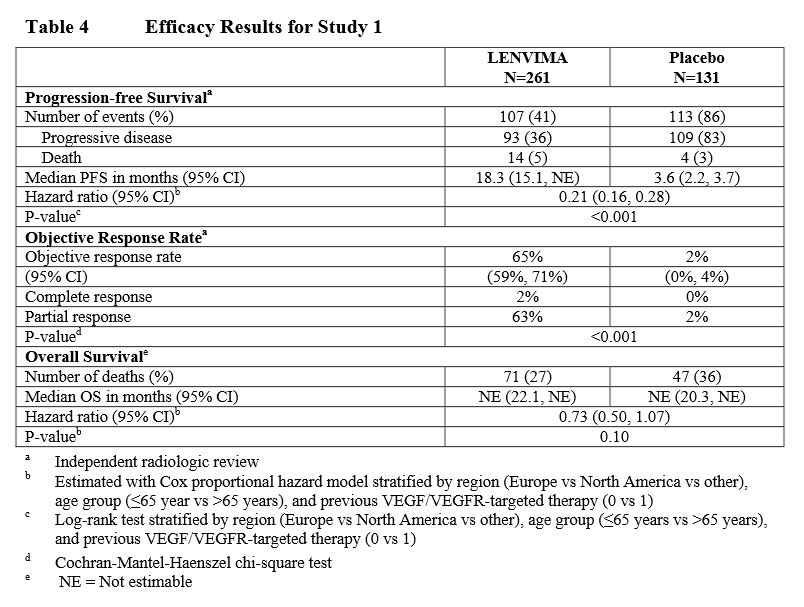
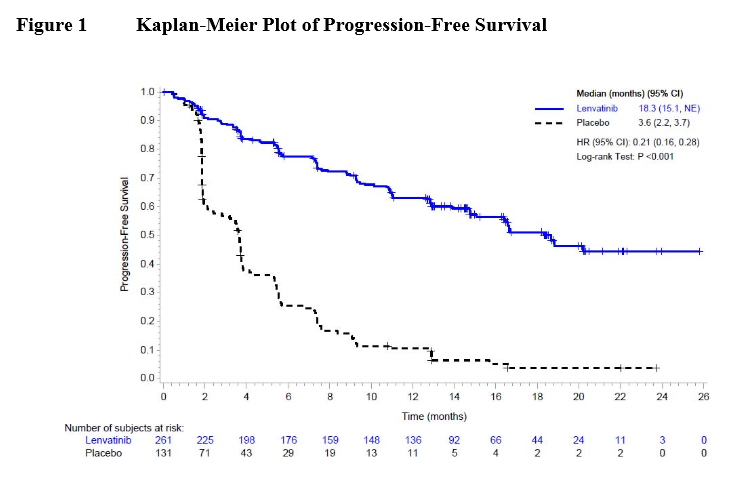
How Supplied
- Lenvatinib 4 mg capsules are supplied as hard hypromellose capsules with yellowish-red body and yellowish-red cap, marked in black ink with “Є” on the cap and “LENV 4 mg” on the body.
- Lenvatinib 10 mg capsules are supplied as hard hypromellose capsules with yellow body and yellowish-red cap, marked in black ink with “Є” on the cap and “LENV 10 mg” on the body.
- Lenvatinib capsules are supplied in cartons of 6 cards. Each card is a 5-day blister card as follows:
- NDC 62856-724-30: 24 mg, carton with 6 cards NDC 62856-724-05 (ten 10 mg capsules and five 4 mg capsules per card).
- NDC 62856-720-30: 20 mg, carton with 6 cards NDC 62856-720-05 (ten 10 mg capsules per card).
- NDC 62856-714-30: 14 mg, carton with 6 cards NDC 62856-714-05 (five 10 mg capsules and five 4 mg capsules per card).
- NDC 62856-710-30: 10 mg, carton with 6 cards NDC 62856-710-05 (five 10 mg capsules per card).
Storage
- Store at 25°C (77°F); excursions permitted to 15–30°C (59–86°F) .
Images
Drug Images
{{#ask: Page Name::Lenvatinib |?Pill Name |?Drug Name |?Pill Ingred |?Pill Imprint |?Pill Dosage |?Pill Color |?Pill Shape |?Pill Size (mm) |?Pill Scoring |?NDC |?Drug Author |format=template |template=DrugPageImages |mainlabel=- |sort=Pill Name }}
Package and Label Display Panel
{{#ask: Label Page::Lenvatinib |?Label Name |format=template |template=DrugLabelImages |mainlabel=- |sort=Label Page }}
Patient Counseling Information
- Advise the patient to read the FDA-approved patient labeling (Patient Information).
- Hypertension: Advise patients to undergo regular blood pressure monitoring and to contact their health care provider if blood pressure is elevated .
- Cardiac Dysfunction: Advise patients that Lenvatinib can cause cardiac dysfunction and to immediately contact their healthcare provider if they experience any clinical symptoms of cardiac dysfunction such as shortness of breath or swelling of ankles .
- Arterial Thrombotic Events Advise patients to seek immediate medical attention for new onset chest pain or acute neurologic symptoms consistent with myocardial infarction or stroke .
- Hepatotoxicity: Advise patients that they will need to undergo lab tests to monitor for liver function and to report any new symptoms indicating hepatic toxicity or failure .
- proteinuria and Renal Failure/Impairment: Advise patients that they will need to undergo regular lab tests to monitor for kidney function and protein in the urine.
- Gastrointestinal perforation or fistula formation: Advise patients that Lenvatinib can increase the risk of gastrointestinal perforation or fistula and to seek immediate medical attention for severe abdominal pain .
- Hemorrhagic Events: Advise patients that Lenvatinib can increase the risk for bleeding and to contact their health care provider for bleeding or symptoms of severe bleeding .
- Embryofetal Toxicity: Advise females of reproductive potential of the potential risk to a fetus and to inform their healthcare provider of a known or suspected pregnancy . Advise females of reproductive potential to use effective contraception during treatment with Lenvatinib and for at least 2 weeks following completion of therapy
- Lactation: Advise nursing women to discontinue breastfeeding during treatment with Lenvatinib
Precautions with Alcohol
- Alcohol-Lenvatinib interaction has not been established. Talk to your doctor about the effects of taking alcohol with this medication.
Brand Names
- Lenvima®
Look-Alike Drug Names
There is limited information regarding Lenvatinib Look-Alike Drug Names in the drug label.
Drug Shortage Status
Price
References
The contents of this FDA label are provided by the National Library of Medicine.
{{#subobject:
|Page Name=Lenvatinib
|Pill Name=No image.jpg
|Drug Name=
|Pill Ingred=|+sep=;
|Pill Imprint=
|Pill Dosage={{{dosageValue}}} {{{dosageUnit}}}
|Pill Color=|+sep=;
|Pill Shape=
|Pill Size (mm)=
|Pill Scoring=
|Pill Image=
|Drug Author=
|NDC=
}}
{{#subobject:
|Label Page=Lenvatinib |Label Name=
}}
{{#subobject:
|Label Page=Lenvatinib |Label Name=
}}